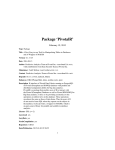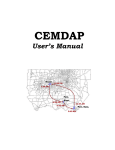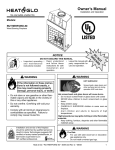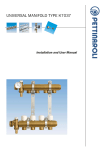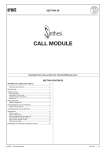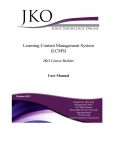Download EDOBE XDOM PMML Instruction manual
Transcript
IBM® Netezza® Analytics
Release 2.0.1
IBM Netezza Analytics
Release Notes
Part Number 00J2008-03 Rev. 2
Note: Before using this information and the product that it supports, read the information in “Notices and Trademarks” on
page 29.
© Copyright IBM Corporation 2011, 2012.
US Government Users Restricted Rights – Use, duplication or disclosure restricted by GSA ADP Schedule Contract with IBM
Corp.
Contents
General IBM Netezza Analytics Topics ...................................................6
IMPORTANT – Read First Before Installing This Release.....................................................6
Database Compatibility......................................................................................................6
Compatibility With Prior Releases.....................................................................................6
Compatibility With Revolution R Enterprise for IBM Netezza...........................................6
Appliance Workload Impact....................................................................................................6
New Features in Netezza Analytics Release 2.0.....................................7
Call Interface Changes to Analytic Functions.........................................................................7
FPGROWTH Algorithms Renamed and Modified.................................................................11
Modified Default Parameter Settings for DECTREE and REGTREE...................................11
Decision Trees.................................................................................................................11
Regression Trees............................................................................................................12
Time Series Forecasting.......................................................................................................12
Missing Value Support in Analytics Functions......................................................................12
Changes to the KMEANS Algorithm ...................................................................................13
Metadata Management For Analytic Models........................................................................13
Limited PMML Support for Analytic Models..........................................................................13
Logistic Regression and Generalized Linear Models (GLM) ...............................................14
Netezza Lua API for Analytics ..............................................................................................14
Perl Adapter For User-Defined Analytic Procedures ...........................................................14
Changes to nzMatrix.............................................................................................................15
Simplified Matrix Multiplication .......................................................................................15
New Random Number Generators..................................................................................16
Changes to Netezza Spatial ................................................................................................17
Issues Fixed In Release 2.0 ....................................................................19
Known Issues in Release 2.0 .................................................................21
Netezza Analytics Release 2.0.1 ............................................................27
Call Interface Changes.........................................................................................................27
Issues Fixed In Release 2.0.1..............................................................................................27
Documentation Changes......................................................................................................27
3
Notices and Trademarks.........................................................................29
Notices.............................................................................................................................29
Trademarks......................................................................................................................31
Regulatory and Compliance............................................................................................31
4
General IBM Netezza Analytics Topics
General IBM Netezza Analytics Topics
IMPORTANT – Read First Before Installing This Release
Database Compatibility
This release of the IBM Netezza Analytics (referred to as Netezza Analytics in the remainder of this document) supports Netezza systems that run release 6.0.5P5 or later. If your
Netezza system is using an earlier release, you must upgrade it before using this release
of Netezza Analytics.
Compatibility With Prior Releases
Release 2.0 introduced some changes to algorithms that are not backward compatible or
that change the behavior of the algorithm. If you have applications that call Netezza Analytics algorithms, you may need to change the algorithm calls in cases where the algorithm's
parameters have changed, the default behavior changed, or the algorithm name changed.
For more information on these backward compatibility issues see the following sections:
Call Interface Changes to Analytic Functions
FPGROWTH Algorithms Renamed and Modified
Changes to the KMEANS Algorithm
Changes to nzMatrix
Compatibility With Revolution R Enterprise for IBM Netezza
This release of Netezza Analytics requires Revolution R Enterprise for IBM Netezza release 5.0.3 or greater.
Appliance Workload Impact
Netezza Analytics functionality is broad and powerful, and as such, utilizes various resources on the appliance. In some instances the resources required to perform certain analytic operations could be substantial (for example, large matrix calculations). Many safeguards are in place to ensure continued performance of the overall appliance, but it should
be noted that when performing complex operations there could be an impact on other “normal” systems-related activity. If you experience performance differences on your “normal”
systems, take note of what, if any, analytic operations are simultaneously being performed.
In the future you can run these operations at a time that does not impact critical operations
or you can adjust settings to run the analytic operations with a lower priority.
6
New Features in Netezza Analytics Release 2.0
Call Interface Changes to Analytic Functions
The call interface to many analytic functions has changed in this release. The modifications
were implemented to provide uniformity and consistency between all algorithms and also to
accomplish the following goals:
Support for definition of nominal and numeric attributes, providing uniform processing
for different data types
Support for column properties
Support for “check mode” facility when calling algorithms
Support for handling missing values (see the new feature description Missing Value
Support in Analytics Functions)
Standardized event messages and parameter validation
In the calls to analytic stored procedures, changes fall into the following categories:
Elimination of specific named parameters that identify column(s) to be used by the algorithm (in various roles). Instead input columns are provided in the 'incolumn' parameter.
Addition of 'roles' associated with columns
Situations where 'outtable' or other named parameter has been replaced by 'model' in
cases where the output from an algorithm is a model.
Combining multiple values for 'class', 'class1', 'class2' parameters into one 'class' parameter.
Backward Compatibility
Not all algorithms have backward compatibility with the changed call interface. For those
that do not (listed in the table below), you must change your calls. It is highly recommended that you also change calls for those algorithms that do provide backward compatibility,
since in the future this backward compatibility will be deprecated.
7
Call Interface Changes to Analytic Functions
The table below lists functions with a changed call interface and provides examples of the
changes through sample calls. Only the changed portion of the parameter list is shown; the
ellipse (…) in the sample call assumes that other required parameters are provided and
have not changed from an older release to this release. The table also notes whether backward compatibility is available:
Prior Release (old way)
(Sample partial call)
Release 2.0 (new way)
(Sample partial call)
Backward
Compatible?
/Notes
call nza..ANOVA_CRD_TEST(
'variable=yield, ...');
call nza..ANOVA_CRD_TEST(
'incolumn=yield, … ');
No
call nza..ANOVA_RBD_TEST(
'variable=val, ...');
call nza..ANOVA_RBD_TEST(
'incolumn=val, ...');
No
call nza..BITABLE(
'incolumn1=income; incolumn2=education ...')
call nza..BITABLE('
'incolumn=income:x; education:y,
...')
No/Changed
in Release
2.0.1
call nza..CANONICAL_CORR(
call nza..CANONICAL_CORR (
'X=residualsugar; acidity, Y=density; pH, 'incolumn=residualsugar:X;
...');
acidity:X; density:Y; pH:Y, ...');
No
call nza..CHISQ_TEST(
'X=race, Y=sex, ...');
call nza..CHISQ_TEST(
'incolumn=race; sex, ...');
No
call nza..COND_ENTROPY
('X=age, Y=wage_per_hour, ...);
call nza..COND_ENTROPY(
No
'incolumn=age:X; wage_per_hour:Y,
...');
call nza..CORR(
'X=age, Y=wage_per_hour, ...');
call nza..CORR(
No
'incolumn=age; wage_per_hour, ...');
call nza..CORRELATION1000MATRIX(
'x=sepallength;sepalwidth,
y=petallength;petalwidth, ...');
call nza..CORRELATION1000MATRIX( No
'incolumn=sepallength:X;
sepalwidth:X; petallength:Y;
petalwidth:Y, ...');
call nza..CORRELATION500PAIRS(
'x=sepallength;sepalwidth,
y=petallength;petalwidth, ...');
call nza..CORRELATION500PAIRS(
'incolumn=sepallength:petallength;
sepalwidth:petalwidth, ...');
call nza..COV(
'X=age, Y=wage_per_hour, ...');
call nza..COV(
No
'incolumn=age; wage_per_hour, ...');
call nza..COVARIANCE1000MATRIX(
'x=sepallength;sepalwidth,
y=petallength;petalwidth, ...');
call nza..COVARIANCE1000MATRIX(
'incolumn=sepallength:X;
sepalwidth:X; petallength:Y;
petalwidth:Y, ...');
No
call nza..COVARIANCE500PAIRS(
'x=sepallength;sepalwidth,
y=petallength;petalwidth, ...');
call nza..COVARIANCE500PAIRS(
'incolumn=sepallength:petallength;
sepalwidth:petalwidth, ...');
No
call nza..COVARIANCEMATRIX(
call nza..COVARIANCEMATRIX(
'X=wage_per_hour;capital_gains, Y=age, 'incolumn=wage_per_hour:X;
...');
capital_gains:X; age:Y, ...');
8
No
No
Call Interface Changes to Analytic Functions
Prior Release (old way)
(Sample partial call)
Release 2.0 (new way)
(Sample partial call)
Backward
Compatible?
/Notes
call nza..CUMULATIVE(
'X=somecol, ...');
call nza..CUMULATIVE(
'incolumn=somecol, ...');
No
call nza..DENSITY('X=somecol, ...');
call nza..DENSITY('
incolumn=somecol, ...');
No
call nza..ENTROPY('X=WORKCLASS,
...');
call nza..ENTROPY('
incolumn=WORKCLASS, ...');
No
call nza..JOINT_ENTROPY(
'X=age, Y=wage_per_hour, ...');
call nza..JOINT_ENTROPY
No
('incolumn=age; wage_per_hour, ...');
call nza..MOMENTS(
'X=hours_per_week, ...');
call nza..MOMENTS(
'incolumn=hours_per_week, ...');
No
call nza..MTBNET_GROW(
'varlist=SEPALLENGTH; SEPALWIDTH;
PETALLENGTH, ...');
call nza..MTBNET_GROW(
'incolumn=SEPALLENGTH;
SEPALWIDTH; PETALLENGTH, ...');
No
call nza..MUTUALINFO(
'X=age, Y=wage_per_hour, ...');
call nza..MUTUALINFO(
No
'incolumn=age; wage_per_hour, ...');
call nza..MWW_TEST(
'x=HOURS_PER_WEEK, ...');
call nza..MWW_TEST(
No
'incolumn=HOURS_PER_WEEK, ...');
call nza..PMML_DECTREE( ' ...');
(function deprecated)
call nza..PMML_MODEL( ' ...');
Yes
call nza..PMML_NAIVEBAYES( ' ...');
(function deprecated)
call nza..PMML_MODEL( ' ...');
Yes
call nza..PRINT_DECTREE( ' ...');
(function deprecated)
call nza..PRINT_MODEL( ' ...');
Yes
call nza..PRINT_REGTREE( ' ...');
(function deprecated)
call nza..PRINT_MODEL( ' ...');
Yes
call nza..PPOINT('X=somecol, ...');
call nza..PPOINT('
incolumn=somecol, ...');
No
call nza..SPEARMAN_CORR_S(
'X=RESIDUALSUGAR, Y=CHLORIDES,
...');
call nza..SPEARMAN_CORR_S(
'incolumn=RESIDUALSUGAR;
CHLORIDES, ...');
No
call nza..SPEARMAN_CORR(
'X=RESIDUALSUGAR, Y=CHLORIDES,
...');
call nza..SPEARMAN_CORR(
'incolumn=RESIDUALSUGAR;
CHLORIDES, ...');
No
call nza..STD_NORM(
'transform=S:petallength; L:petallength;
N:petallength; U:petallength;
C:sepallength/petallength, ...');
call nza..STD_NORM(
'incolumn=petallength:S;
petallength:L; petallength:N;
petallength:U; sepallength/petallength:C, ...');
No
9
Call Interface Changes to Analytic Functions
Prior Release (old way)
(Sample partial call)
Release 2.0 (new way)
(Sample partial call)
Backward
Compatible?
/Notes
call nza..SUMMARY1000(
'varlist=FIXED_ACIDITY;
VOLATILE_ACIDITY; CITRIC_ACID;
RESIDUALSUGAR, ...');
call nza..SUMMARY1000(
'incolumn=FIXED_ACIDITY;
VOLATILE_ACIDITY; CITRIC_ACID;
RESIDUALSUGAR, ...');
No
call nza..T_LS_TEST
('X=petallength, Y=sepallength, ...');
call nza..T_LS_TEST(
'incolumn=petallength:X;
sepallength:Y, ...);
No
call nza..T_ME_TEST
('X=petallength, ...');
call nza..T_ME_TEST(
'incolumn=petallength, ...');
No
call nza..T_PMD_TEST(
'X=petallength, Y=sepallength, ...');
call nza..T_PMD_TEST(
'incolumn=petallength:X;
sepallength:Y, ...');
No
call nza..T_UMD_TEST
call nza..T_UMD_TEST(
No
('X=sepalwidth, class=class, class1="vir- 'incolumn=petallength,
ginica", class2="versicolor", ...');
class=class:"virginica":"setosa", ...
');
call nza..TBNET_GROW(
'varlist=SEPALLENGTH; SEPALWIDTH;
PETALLENGTH; PETALWIDTH, ...');
call nza..TBNET_GROW(
'incolumn=SEPALLENGTH;
SEPALWIDTH; PETALLENGTH;
PETALWIDTH, ...');
Yes
call nza..TBNET1G(
'varlist=SEPALLENGTH; SEPALWIDTH;
PETALLENGTH;PETALWIDTH, ...');
call nza..TBNET1G(
'incolumn=SEPALLENGTH;
SEPALWIDTH;
PETALLENGTH;PETALWIDTH, ...');
No
call nza..TBNET1G2P(
'varlist1=SEPALLENGTH; SEPALWIDTH,
varlist2=PETALLENGTH; PETALWIDTH,
...');
call nza..TBNET1G2P(
No
'incolumn=SEPALLENGTH:X; SEPALWIDTH:X; PETALLENGTH:Y;
PETALWIDTH:Y, ...');
call nza..TBNET2G(
'varlist1=SEPALLENGTH; SEPALWIDTH,
varlist2=PETALLENGTH; PETALWIDTH,
...');
call nza..TBNET2G(
No
'incolumn=SEPALLENGTH:X; SEPALWIDTH:X; PETALLENGTH:Y;
PETALWIDTH:Y, ...');
call nza..WILCOXON_TEST(
call nza..WILCOXON_TEST(
No
'X=VOLATILE_ACIDITY, Y=CITRIC_ACID, 'incolumn=VOLATILE_ACIDITY; CIT...');
RIC_ACID, ...');
For general rules regarding the call interface for analytic algorithms, see “Call Interface” in
the IBM SPSS In-Database Analytics Developer's Guide. For complete usage information,
see the IBM SPSS In-Database Analytics Reference Guide.
FPGROWTH Algorithms Renamed and Modified
The FPGROWTH algorithm has been renamed to ARULE and some parameters have
changed. There is no backward compatibility; the FPGROWTH algorithms are no longer
10
FPGROWTH Algorithms Renamed and Modified
supported. The table below shows sample calls for both the older and new algorithm
names.
Prior Release (old way)
Release 2.0 (new way)
CALL nza..PREPARE_FPGROWTH(
'intable=nza..quant_sales, outtable=dset, tid=tid,
item=idart');
CALL nza..PREPARE_ARULE(
'intable=nza..quant_sales, outtable=dset, tid=tid,
item=idart');
CALL nza..FPGROWTH('intable=nza..retail,
pfx=results, support=1 ');
CALL nza..ARULE('intable=nza..retail,
model=assoc, supporttype=percent, support=5,
lvl=0, maxsetsize=5, confidence=0.5');
Detailed information about these algorithms can be found in the IBM SPSS In-Database
Analytics Developer's Guide and the IBM SPSS In-Database Analytics Reference Guide.
Modified Default Parameter Settings for DECTREE and
REGTREE
Default parameter settings for decision and regression tree growing are modified in this release to yield smaller trees. The previous defaults resulted in creating large trees, maximally fitted to the training data (good candidates for pruning). Growing, pruning, and using
such large trees for prediction is computationally expensive and often unnecessary. By using modified parameter settings, you can obtain substantial computational savings. The algorithms are usually run with their default settings, so those defaults are changed to produce smaller trees. To force large tree growing, those users with an understanding of the
performance impact can change the parameter settings.
Decision Trees
The following default parameter settings are changed:
Parameter
New Value
Old Value
Description
minsplit
50
2
The minimum number of instances in a node required for a split. If
the number of instances in a node is less than minsplit, no further
split is applied and the node becomes a leaf.
maxdepth
10
62
The maximum decision tree depth. If a node's level in the tree
equals maxdepth (with the level of the root node equal 1, the level
of its descendants equal 2, etc.), no further split is applied and the
node becomes a leaf.
minimprove
0.02
0.01
The minimum improvement of the evaluation function used for
split selection (class impurity measure) required for a split. If the
decrease of class impurity (calculated using the function specified
via the eval argument, defaulting to the entropy) is less than minimprove, no further split is applied and the node becomes a leaf.
Regression Trees
The following default parameter setting is changed:
11
Modified Default Parameter Settings for DECTREE and REGTREE
Parameter
minsplit
New Value
50
Old Value
2
Description
The minimum number of instances in a node required for a split. If
the number of instances in a node is less than minsplit, no further
split is applied and the node becomes a leaf.
Time Series Forecasting
Support for Time Series is introduced in this release. A time series is a sequence of numerical data values, measured at successive, but not necessarily equidistant points in time.
Examples are daily stock prices, monthly unemployment counts, or annual changes in
global temperature. The two main goals of time series analysis are to understand the underlying patterns that are represented by the observed data and to make forecasts. Time
Series support is implemented with the following new algorithm:
TIMESERIES (NVARCHAR(ANY) paramString)
Detailed information about this algorithm can be found in the “Time Series Forecasting”
section of the IBM SPSS In-Database Analytics Developer's Guide.
Missing Value Support in Analytics Functions
In prior releases of Netezza Analytics, analytic algorithms were unable to work with tables
that were missing values in the columns being used in the algorithm's calculation. Because
many real world databases suffer from missing values in tables, preprocessing was required in these cases to either remove rows or columns with missing values, replace missing values with some special value, or to impute the value by using the Netezza Analytics
supplied IMPUTE_DATA procedure. New to this release is an internal solution built into various algorithms to deal with the missing values. This provides:
A more convenient solution
Possibly better model quality
Possibly better predictions
The following selected algorithms are capable of building or applying models using tables
with missing values, internally handling missing values in an appropriate manner (instead
of just ignoring instances with missing values):
Decision Trees
Regression Trees
Naïve Bayes classifier
For other algorithms, if rows contain missing values, the rows are ignored, but the table is
still used. Preprocessing is still possible, using the Netezza Analytics supplied
IMPUTE_DATA procedure, but is not required. Note that preprocessing is not “automated.”
Detailed information about how missing values are handled can be found in the IBM SPSS
In-Database Analytics Developer's Guide.
Changes to the KMEANS Algorithm
The following new features were added to the existing KMEANS algorithm:
12
Changes to the KMEANS Algorithm
Clustering using Mahalanobis distance
Normalized Euclidean distance
Scoring with statistics of clusters and columns
Automatic data normalization and standardization
Enriched statistics
See “KMEANS algorithm” and “Enriched Statistics for Clustering Models” in the IBM SPSS
In-Database Analytics Developer's Guide for details of these new features.
In this release there is a behavior change to the KMEANS algorithm. By default, the 'normalized Euclidean distance' is used by the KMEANS algorithm if the distance option is not
specified. In prior releases, 'Euclidean distance' is the default distance used.
Metadata Management For Analytic Models
The primary goal of the new Metadata Management feature is to provide an environment
for managing the analytic models created by the Netezza Analytics software. The implementation of the Metadata Management component is done on top of the existing database
system, using stored procedures and user-defined functions.
All analytics models created by the various Netezza Analytics functions (like DECTREE or
KMEANS) are registered in a catalog, and new administrative and other functions are offered for model management. The Metadata Management system provides the following
features:
List information about models
Perform basic operations on models (for example, delete, copy, rename, update)
Perform advanced operations on models ( for example print, PMML format, export)
Security (grant and revoke privileges on models and model operations)
Note that this new feature is required by all algorithms that generate models. When you enable a database for Netezza Analytics using the script create_inza_db.sh, the database is
automatically prepared for the Metadata Management feature.
This new feature is described in more details in the “Metadata Management” section of the
IBM SPSS In-Database Analytics Developer's Guide.
Most models created using prior releases of Netezza Analytics can be registered in the
metadata catalog so that they can be used with Metadata Management. If model migration
is needed, it is done automatically. See the REGISTER_MODEL procedure in the IBM
SPSS In-Database Analytics Developer's Guide.
Limited PMML Support for Analytic Models
PMML (Predictive Model Markup Language) is defined by the Data Mining Group (DMG)
and is the widely accepted standard for the exchange of data mining models. Limited
PMML support is provided in this version. Support will be producer conformance for decision tree (classification), association rules, naïve Bayes, and k-means (clustering) models.
PMML support enables users to employ PMML-conformant model visualization tools, such
as the InfoSphere Warehouse visualizer, for model exploration. It also allows scoring of
Netezza Analytics models in DB2. The following algorithms have limited PMML support:
Decision trees
13
Limited PMML Support for Analytic Models
K-means
Association rules (ARULE)
Naïve Bayes
Support is implemented with the following new analytic procedures:
PMML_MODEL
EXPORT_PMML
This new feature is described in more details in the “PMML” section of the IBM SPSS InDatabase Analytics Developer's Guide.
Logistic Regression and Generalized Linear Models (GLM)
New to this release are algorithmic procedures to support GLM. These are:
GLM
PREDICT_GLM
Detailed information on these new procedures can be found in the “Generalized Linear
Models” section of the IBM SPSS In-Database Analytics Developer's Guide.
Netezza Lua API for Analytics
Beginning with Release 2.0, Netezza Analytics includes a variant of Lua, which enables
users to take advantage of the Netezza appliance's highly parallelized environment. Lua is
an extension programming language designed to support general procedural programming
with data description facilities. It also offers good support for object-oriented programming,
functional programming, and data-driven programming. Lua is intended to be used as a
powerful, lightweight scripting language for any program that needs one. For more information on Netezza Lua, see the IBM Netezza Lua Developer's Guide.
Perl Adapter For User-Defined Analytic Procedures
Users can extend SQL with user-defined functions (UDXs) as well as user-defined analytic
processes (UDAPs). The UDAP concept allows a user to implement a freestanding, executable data-processing program that runs “out of process” (that is, outside the database
system), and register it in a database. UDAPs provide several important features that are
not available with a UDX. For example, a UDX must be coded in C++ but UDAPs can be
written in a variety of languages, allowing users to capitalize on their existing programming
skills. Release 2.0 provides support for writing UDAPs in the Perl language. For more information on UDAPs and the Perl Adapter, see the User-Defined Analytics Process Developer's Guide.
Changes to nzMatrix
nzMatrix has improved the matrix multiplication procedure (GEMM) and introduced new
random number generators in this release.
14
Changes to nzMatrix
Simplified Matrix Multiplication
The matrix multiplication procedure (GEMM) has been simplified. Previously, users chose
whether to use GEMM or GEMM_LARGE, based on speed requirements and matrix size.
(GEMM was faster but could not calculate larger matrices.) With this release, the GEMM
procedure has been enhanced and GEMM_LARGE is no longer required. Beginning
with this release, GEMM uses the following signatures (the second being previously part of
GEMM_LARGE):
GEMM (nvarchar(any), nvarchar(any), nvarchar(any))
GEMM (nvarchar(any), BOOLEAN, nvarchar(any), BOOLEAN, nvarchar(any)))
The system selects the appropriate algorithm, transparent to the user, based on the size of
the processed matrices and architecture of the hardware. Note that, for backward compatibility, the system continues to recognize the GEMM_LARGE stored procedure.
15
Changes to nzMatrix
New Random Number Generators
This Netezza Analytics release introduces a new set of wrappers on the Intel Math Kernel
Library® random number generators (RNGs). The API provides a set of stored procedures
that generate matrices filled with random values. Following are the new stored procedures:
Stored Procedure
Description
CREATE_RANDOM_CAUCHY_MATRIX
Create a random matrix using Cauchy distributed random values
CREATE_RANDOM_EXPONENT_MATRIX
Create a random matrix using Exponential distributed
random values
CREATE_RANDOM_GAMMA_MATRIX
Create a matrix of pseudo-random variables following
the Gamma distribution
CREATE_RANDOM_LAPLACE_MATRIX
Create a matrix of pseudo-random variables following
the Laplace distribution
CREATE_RANDOM_NORMAL_MATRIX
Create a matrix of pseudo-random variables following
the normal distribution
CREATE_RANDOM_POISSON_MATRIX
Create a matrix of pseudo-random variables following
the Poisson distribution
CREATE_RANDOM_RAYLEIGH_MATRIX
Create a Matrix of random using a Rayleigh distributed random values generator
CREATE_RANDOM_UNIFORM_MATRIX
Create a matrix of pseudo-random variables following
the uniform distribution
CREATE_RANDOM_WEIBULL_MATRIX
Create a matrix of pseudo-random variables following
the Weibull distribution
See Intel Math Kernel Library Vector Statistical Library Notes for more information:
http://software.intel.com/sites/products/documentation/hpc/mkl/vslnotes/vslnotes.pdf
16
Changes to Netezza Spatial
Changes to Netezza Spatial
Spatial precision has changed such that coordinate values display only the value's significant digits up to fifteen digits of precision which is the maximum for 64-bit floating point values. Prior to 2.0, by default, the user would always see 16 decimal digits. This means that
any trailing 0's at the end of a value will now be truncated in this release. For example, prior to this release the user would have seen the following:
INZA(ADMIN)=> select st_astext(st_wkttosql('point (10 16)'));
ST_ASTEXT
------------------------------------------------POINT (10.0000000000000000 16.0000000000000000)
(1 row)
With 2.0 they will now see:
INZA(ADMIN)=> select st_astext(st_wkttosql('point (10 16)'));
ST_ASTEXT
--------------POINT (10 16)
(1 row)
Additionally, prior to this release, the user could control the number of decimal digits as follows:
INZA(ADMIN)=> select st_astext(st_wkttosql('point (10 16)'), 8);
ST_ASTEXT
--------------------------------POINT (10.00000000 16.00000000)
(1 row)
With this release this option is no longer available.
17
Issues Fixed In Release 2.0
Reference
Topic/Area
Issue Description
EXT-1084
PCA
Performance Improvements
EXT-1509
ARULE (formerly FPGROWTH) Performance Improvements
EXT-1518
Netezza Matrix Engine
When using RCV2SIMPLE_NUM or RCV2SIMPLE to
convert a row/column/value table to a “simple” matrix
table may fail if the number of projected columns is
greater than 1600.
EXT-1591
DECTREE
Performance Improvements for large datasets.
EXT-1647
Algorithm
MSE,CAE, RAE, RSE return null instead of an error
when column does not contain unique value.
EXT-1688
DECTREE
Performance Improvements. Full class distribution enhances model inspection possibilities and may improve probabilistic prediction quality.
EXT-2097
Matrix
Previous version of CREATE_MATRIX_FROM_TABLE introduced a decrease of performance for valid,
dense input tables. This fix improves performance for
DENSE input data.
EXT-2113
Matrix
Performance Improvement to nzm..CONCAT procedure.
19
Known Issues in Release 2.0
The following are known issues in Release 2.0. Those references numbers shown in red
have been fixed in a later patch release.
Reference
Topic/Area
Netezza Matrix
Engine
Issue Description / Workaround
Using CTRL-C in nzsql typically aborts and rolls back the transaction in progress. However, it is possible that the Matrix Engine
processes continue running and consuming resources. To check
if any Matrix Engine processes are running, use the following
SQL query:
CALL NZA..SP_MPI_STATS();
To abort a Matrix Engine, use the following SQL query (replacing
"123456789" with the engine’s job ID):
CALL NZM..KILL_ENGINE(123456789);
Netezza Matrix
Engine
Calculations using PBLAS or ScaLAPACK consume S-Blade
RAM for storing input matrices, intermediate work matrices, and
result matrices. Each matrix element consumes 8 bytes. Exceeding available RAM may result in S-Blade restarts and aborted
computations. Available RAM equals total RAM minus the RAM
requirements of the Linux operating system, the Netezza system,
and concurrent, unrelated queries.
When using matrices please keep these maximum numbers in
mind. In future version more controls will be implemented to help
guard against exceeding these limits.
Netezza Matrix
Engine
An issue can exist if the matrix engine attempts to take up too
much memory on the Netezza system (if the size of the matrix
and its calculations becomes too large).
From a user's perspective, you may experience two situations:
The matrix operation returns with “Out of memory” exception when the internal MatrixEngine assertion fails.
Matrix operation returns with a “timeout” error when it is
killed by our OOM guard.
Netezza Matrix
Engine
The Netezza Matrix Engine uses the double precision (64-bit)
floating point approximate numeric data type for storage and
computation of matrix element values.
Row and column indices are stored as 32-bit integer values, allowing up to 2,147,483,647 rows and columns. Row and column
indices begin at 1. An index value of zero is not permitted.
EXT-836
R Analytic Executa- Depending on the data types used for records, transfer of data
bles
from the table to R memory can be very slow.
EXT-951
QUANTILE_DISC
Use of the QUANTILE_DISC function may cause a core dump.
21
Known Issues in Release 2.0
Reference
EXT-1107
Topic/Area
Netezza Spatial
Package
Issue Description / Workaround
A ST_DWithin function performed on two points does not return
TRUE when increasing the distance value past 18945535.
nzsql -u $NZ_USER -pw $NZ_PASSWORD -c "SELECT
ST_DWithin(ST_Point(0,0), ST_Point(0,1), 18945535,
'meter', 'wgs84');"
ST_DWITHIN
-----------t
(1 row)
nzsql -u $NZ_USER -pw $NZ_PASSWORD -c "SELECT
ST_DWithin(ST_Point(0,0), ST_Point(0,2), 18945536,
'meter', 'wgs84');"
ST_DWITHIN
-----------f
(1 row)
EXT-1223
Netezza Matrix
Engine
All matrices in a database are owned by INZAUSER. Also, any
"inza user" in the database runs the Matrix Engine commands as
INZAUSER. Therefore, if user A creates a matrix, then user B
can see the matrix. It is not possible to grant that permission (or
revoke it) to make matrices invisible to users.
This is in conflict with all other database objects in a Netezza
system. Objects have permissions granted on them (or revoked
on them) to users - otherwise the users cannot see them or operate on them.
Furthermore, any Netezza Analytics user in a database can drop
any other user's matrices. There is no protection.
EXT-1224
Netezza Matrix
Engine
(Related to EXT-1223)
Users who have not been given permissions to a particular database on the Netezza System may still be able to list, view, print,
and delete matrices on that database, despite not being able to
affect tables. For example:
CALL nzm..list_matrices();
CALL nzm..print('ones5x5');
CALL nzm..delete_matrix('ones5x5');
EXT-1225
Netezza Matrix
Engine
If a user is granted Netezza Analytics permissions in a particular
database, then that user can use Netezza Analytics functions in
any other database where they have user permissions (except
nzMatrix functions).
Note that when you grant a user access to Netezza Analytics,
you are performing a global operation, not a per-database operation, with the exception of nzMatrix which is database-local.
While working as designed, improper use may cause issues.
EXT-1248
KNN, KMEANS
DATE type is not supported by KNN and KMEANS algorithms
EXT-1249
MUTUALINFO
The MUTUALINFO procedure may hang when run on a IBM
Netezza 1000-12.
EXT-1255
Netezza Analytics
Moments, correlations, covariance, Bayesian networks, and
standardization/normalization stored procedures do not allow
NULL values. To use these stored procedures, all NULL values
must be removed from the data.
22
Known Issues in Release 2.0
Reference
Topic/Area
Issue Description / Workaround
EXT-1413
Netezza Analytics
Some objects in the database are owned by ADMIN instead of
INZAUSER, which may cause access issues.
EXT-1593
DECTREE,
REGTREE
Tree scoring has a non linear scoring curve.
EXT-1801
TBNET1G2P
Algorithm TBNET1G2P does not support column properties in
metadata management tables
EXT-1928
System
Cron job which cleans remote analytic processes is launched
when there are previous ones still running.
EXT-1955
MTBNET_GROW
Algorithm MTBNET_GROW does not support column properties
in metadata management tables
EXT-1956
TBNET_GROW
Algorithm TBNET_GROW does not support column properties in
metadata management tables
EXT-1957
TBNET1G
Algorithm TBNET1G does not support column properties in
metadata management tables
EXT-1959
TBNET2G
Algorithm TBNET2G does not support column properties in
metadata management tables
EXT-1983
KMEANS
KMeans calling nza..PRINT_MODEL returns an error
PRINT_MODEL function is not supported for this type of model.
EXT-1988
Time Series
Time series, STD does not find the sinus when it is not adapted
to the stepsize.
EXT-1991
and
SWS-74183
Sporadically, when running certain Netezza Analytics algorithms
the following error may occur:
ERROR: 3 : Expected bool return type
This has been noted with naïve bayes algorithms and kmeans.
This is a Netezza system error which will be fixed in an upcoming release. Contact Customer Support for a more up to date status on a patch release to fix this issue.
EXT-2052
User Defined
Problem with NULL field handling in C++ User Defined Analytic
Analytic Executable Executable
EXT-2075
Time Series
Forecasttimes sometimes only returns the last requested time.
EXT-2177
Time Series
Timeseries, if there are no periods FFT seems to discover periods in just noise
EXT-2179
Time Series
Initialization of Seasonal Coefficients for Exponential Smoothing
should use detrended data.
23
Known Issues in Release 2.0
Reference
EXT-2209
and
EXT-2101
Topic/Area
Metadata
Management
Issue Description / Workaround
nzconvertsyscase does not work in conjunction with Netezza Analytics.
Conversion of the system case from uppercase to lowercase or
vice versa using the command "nzconvertsyscase" does not convert the metadata management tables. Before you run this command, you must (for all databases) drop all analytics models and
use the nza..cleanup() procedure to remove the metadata.
After you run the command, you must re-register the Netezza
Analytics component analytics_utils:
nzcm -fr analytics_utils
EXT-2209
and
SWS-72806
and
SWS-74893
Metadata
Management
There are two issues related to backup/restore operations with
regard to Metadata Management.
1.
2.
When you backup a database that contains Netezza Analytics models and restore it on ANOTHER Netezza system, the
table/view references in the metadata tables could be incorrect. If you need to do so, the administrator should set the
object ids used in the metadata tables to the value -1 (for all
databases containing analytics models) after the restore operation: In table NZA_META_MODELS, these are the columns OWNERID and CREATORID; and in table
NZA_META_COMPONENTS, the column OBJID.
Restore of a database containing metadata management
views may fail due to issues SWS-72806 and SWS-74893.
This is a NON-FATAL error; the database and all the data in
the tables will be restored correctly, but some views MAY be
missing. These views can be manually re-created by doing
the following:
●
Log in as ADMIN
●
Find the Model IDs for all models that have a column
properties view registered in MM:
select id from nza_meta_components
where usagetype = 'Column Properties';
●
For all these IDs (here with ID 29 as example), run the
following two internal procedures:
call nza.._sp_meta_remove_component(
29, 'Column Properties', -1);
call nza.._sp_meta_create_column_property_view(
29, 'COLNAME', false);
EXT-2255
STD_NORM
STD_NORM returns columns with null values even though standardization and normalization is feasible. This issue that may indirectly impact KMEANS auto-transformation since KMEANS automatic standardization or normalization may returns columns
with null values when columns have very small variance values.
EXT-2318
TBNET_APPLY
The output table is different in this release. The prediction column is named <colname>_PRED instead of <colname>_pred.
24
Known Issues in Release 2.0
Reference
Topic/Area
Issue Description / Workaround
EXT-2319
nzSpatial
ST_PointOnSurface incorrectly returning a point with empty polygons
EXT-2328
Bayesian Networks
Bayesian Networks are not deterministic in the choice of VARX
and VARY
EXT-2332
KMEANS
The number of numeric columns supported are limited to 55 in
this release when Mahalanobis distance is used for K-means
clustering.
SWS-62976,
EXT-915
Netezza system,
Netezza Analytics
A known issue has surfaced in recent testing regarding algorithms calling the function rank() or over(). When these functions
are called on large data sets (10 billion rows if called once, or 5
billion rows if called twice), you will receive an error similar to,
"ERROR: SPU swap partition: Disk temporary work space is
full." This is due to the function operating on host where there is
not enough disk space to handle the operation.
To solve this issues properly, a Netezza system fix is needed
(SWS-62976). This is currently slated to be included in a patch
release for Netezza systems (date to be determined). Until the fix
is in place, you are limited to a data set less than 5 or 10 billion
rows as noted above.
The following Algorithms use either rank() or over():
rank()
Correlation and Mutual Information
Discretization
FP-Growth
General Diagnostic Measures
KNN
Moments
Non-Parametric Statistics
PCA added to the Analytics documentation
over()
Correlation and Mutual Information
Decision Trees
Discretization
Divisive Clustering
FP-Growth
General Diagnostic Measures
K-means
KNN
Moments
Non-Parametric Statistics
Regression Trees
Sufficient Statistics
25
Netezza Analytics Release 2.0.1
The Netezza Analytics Release 2.0.1 patch release contains bug fixes and improvements
to the documentation.
Call Interface Changes
The call interface to the following analytic function has changed in this release:
Prior Release (old way)
(Sample partial call)
call nza..BITABLE(
'incolumn1=income; incolumn2=education ...')
Release 2.0 (new way)
(Sample partial call)
call nza..BITABLE('
'incolumn=income:x; education:y,
…')
Backward
Compatible?
No
Issues Fixed In Release 2.0.1
The following issues were fixed in this release:
Reference
Topic/Area
Issue Description
EXT-1248
KNN, KMEANS
DATE type working properly when date columns are
treated as nominal.
EXT-2318
TBNET_APPLY
The outtable column name case is no longer an issue.
EXT-2340
nzTApply
The nzTApply function now properly passes column
names when machine is set to lowercase.
EXT-2355
Lua
nzLua now has an API call for the getCurrentUsername() UDX function, allowing a UDX to get the
name of the user executing the UDX.
EXT-2357
timetz literal value
The parameters forecasthorizon and forecasttimes
now accept a colon in the timetz format.
EXT-2361
KMEANS
Calculation of cardinality is now correct when 'statis-
tics = values'.
EXT-2380
Lua
There is now a check for 0 prior to division and
there is no longer a subtraction of 1 from the ending
value.
EXT-2418
Installation
Registration error during installation has been fixed.
EXT-2419
Linear Regression
The t-statistics and p-values for significance of the
regression coefficients, as well as the R^2 coefficient, are now computed correctly.
27
Documentation Changes
Documentation Changes
Release 2.0.1 contains the following two manuals documenting the Netezza Analytics
map/reduce functionality.
IBM Netezza Analytics Map/Reduce API Reference
IBM Netezza Analytics Map/Reduce Developer's Guide
28
Notices and Trademarks
Notices
This information was developed for products and services offered in the U.S.A. IBM may
not offer the products, services, or features discussed in this document in other countries.
Consult your local IBM representative for information on the products and services currently available in your area. Any reference to an IBM product, program, or service is not intended to state or imply that only that IBM product, program, or service may be used. Any
functionally equivalent product, program, or service that does not infringe any IBM intellectual property right may be used instead. However, it is the user's responsibility to evaluate
and verify the operation of any non-IBM product, program, or service.
IBM may have patents or pending patent applications covering subject matter described in
this document. The furnishing of this document does not grant you any license to these
patents. You can send license inquiries, in writing, to:
IBM Director of Licensing
IBM Corporation
North Castle Drive
Armonk, NY 10504-1785 U.S.A.
For license inquiries regarding double-byte character set (DBCS) information, contact the
IBM Intellectual Property Department in your country or send inquiries, in writing, to:
Intellectual Property Licensing
Legal and Intellectual Property Law
IBM Japan Ltd.
1623-14, Shimotsuruma, Yamato-shi
Kanagawa 242-8502 Japan
The following paragraph does not apply to the United Kingdom or any other country where
such provisions are inconsistent with local law: INTERNATIONAL BUSINESS MACHINES
CORPORATION PROVIDES THIS PUBLICATION "AS IS" WITHOUT WARRANTY OF
ANY KIND, EITHER EXPRESS OR IMPLIED, INCLUDING, BUT NOT LIMITED TO, THE
IMPLIED WARRANTIES OF NON-INFRINGEMENT, MERCHANTABILITY OR FITNESS
FOR A PARTICULAR PURPOSE. Some states do not allow disclaimer of express or implied warranties in certain transactions, therefore, this statement may not apply to you.
This information could include technical inaccuracies or typographical errors. Changes are
periodically made to the information herein; these changes will be incorporated in new editions of the publication. IBM may make improvements and/or changes in the product(s)
and/or the program(s) described in this publication at any time without notice.
Any references in this information to non-IBM Web sites are provided for convenience only
and do not in any manner serve as an endorsement of those Web sites. The materials at
those Web sites are not part of the materials for this IBM product and use of those Web
sites is at your own risk.
IBM may use or distribute any of the information you supply in any way it believes appropriate without incurring any obligation to you.
Licensees of this program who wish to have information about it for the purpose of enabling: (i) the exchange of information between independently created programs and other
programs (including this one) and (ii) the mutual use of the information which has been exchanged, should contact:
29
Notices and Trademarks
IBM Corporation
26 Forest Street
Marlborough, MA 01752 U.S.A.
Such information may be available, subject to appropriate terms and conditions, including
in some cases, payment of a fee.
The licensed program described in this document and all licensed material available for it
are provided by IBM under terms of the IBM Customer Agreement, IBM International Program License Agreement or any equivalent agreement between us.
Any performance data contained herein was determined in a controlled environment.
Therefore, the results obtained in other operating environments may vary significantly.
Some measurements may have been made on development-level systems and there is no
guarantee that these measurements will be the same on generally available systems. Furthermore, some measurements may have been estimated through extrapolation. Actual results may vary. Users of this document should verify the applicable data for their specific
environment.
Information concerning non-IBM products was obtained from the suppliers of those products, their published announcements or other publicly available sources. IBM has not tested those products and cannot confirm the accuracy of performance, compatibility or any
other claims related to non-IBM products. Questions on the capabilities of non-IBM products should be addressed to the suppliers of those products.
All statements regarding IBM's future direction or intent are subject to change or withdrawal
without notice, and represent goals and objectives only. This information is for planning
purposes only. The information herein is subject to change before the products described
become available.
This information contains examples of data and reports used in daily business operations.
To illustrate them as completely as possible, the examples include the names of individuals, companies, brands, and products. All of these names are fictitious and any similarity to
the names and addresses used by an actual business enterprise is entirely coincidental.
COPYRIGHT LICENSE:
This information contains sample application programs in source language, which illustrate
programming techniques on various operating platforms. You may copy, modify, and distribute these sample programs in any form without payment to IBM, for the purposes of developing, using, marketing or distributing application programs conforming to the application
programming interface for the operating platform for which the sample programs are written. These examples have not been thoroughly tested under all conditions. IBM, therefore,
cannot guarantee or imply reliability, serviceability, or function of these programs. The sample programs are provided "AS IS", without warranty of any kind. IBM shall not be liable for
any damages arising out of your use of the sample programs.
Each copy or any portion of these sample programs or any derivative work, must include a
copyright notice as follows:
© (your company name) (year). Portions of this code are derived from IBM Corp. Sample
Programs. © Copyright IBM Corp. (enter the year or years). All rights reserved.
Trademarks
IBM, the IBM logo, ibm.com and Netezza are trademarks or registered trademarks of International Business Machines Corporation in the United States, other countries, or both. If
these and other IBM trademarked terms are marked on their first occurrence in this information with a trademark symbol (® or ™), these symbols indicate U.S. registered or com-
30
Notices and Trademarks
mon law trademarks owned by IBM at the time this information was published. Such trademarks may also be registered or common law trademarks in other countries. A current list
of IBM trademarks is available on the Web at “Copyright and trademark information” at ibm.com/legal/copytrade.shtml.
The following terms are trademarks or registered trademarks of other companies:
Adobe is a registered trademark of Adobe Systems Incorporated in the United States,
and/or other countries.
Linux is a registered trademark of Linus Torvalds in the United States, other countries, or
both.
Microsoft, Windows, Windows NT, and the Windows logo are trademarks of Microsoft Corporation in the United States, other countries, or both.
NEC is a registered trademark of NEC Corporation.
UNIX is a registered trademark of The Open Group in the United States and other countries.
Java and all Java-based trademarks are trademarks of Sun Microsystems,
Inc. in the United States, other countries, or both.
Red Hat is a trademark or registered trademark of Red Hat, Inc. in the United States and/or other countries.
D-CC, D-C++, Diab+, FastJ, pSOS+, SingleStep, Tornado, VxWorks, Wind
River, and the Wind River logo are trademarks, registered trademarks, or
service marks of Wind River Systems, Inc. Tornado patent pending.
APC and the APC logo are trademarks or registered trademarks of American Power Conversion Corporation.
Other company, product or service names may be trademarks or service marks of others.
Regulatory and Compliance
Regulatory Notices
Install the Netezza system in a restricted-access location. Ensure that only those trained to
operate or service the equipment have physical access to it. Install each AC power outlet
near the Netezza system rack that plugs into it, and keep it freely accessible. Provide approved circuit breakers on all power sources.
Product may be powered by redundant power sources. Disconnect ALL power sources before servicing. High leakage current. Earth connection essential before connecting supply.
Courant de fuite élevé. Raccordement à la terre indispensable avant le raccordement au
réseau.
Homologation Statement
Attention: This product is not intended to be connected directly or indirectly by any means
whatsoever to interfaces of public telecommunications networks, neither to be used in a
Public Services Network.
FCC - Industry Canada Statement
This equipment has been tested and found to comply with the limits for a Class A digital device, pursuant to part 15 of the FCC rules. These limits are designed to provide reasonable
protection against harmful interference when the equipment is operated in a commercial
31
Notices and Trademarks
environment. This equipment generates, uses, and can radiate radio-frequency energy
and, if not installed and used in accordance with the instruction manual, may cause harmful
interference to radio communications. Operation of this equipment in a residential area is
likely to cause harmful interference, in which case users will be required to correct the interference at their own expense.
This Class A digital apparatus meets all requirements of the Canadian Interference-Causing Equipment Regulations.
Cet appareil numérique de la classe A respecte toutes les exigences du Règlement sur le
matériel brouilleur du Canada.
WEEE
Netezza Corporation is committed to meeting the requirements of the European Union
(EU) Waste Electrical and Electronic Equipment (WEEE) Directive. This Directive requires
producers of electrical and electronic equipment to finance the takeback, for reuse or recycling, of their products placed on the EU market after August 13, 2005.
CE Statement (Europe)
This product complies with the European Low Voltage Directive 73/23/EEC and EMC Directive 89/336/EEC as amended by European Directive 93/68/EEC.
Warning: This is a class A product. In a domestic environment this product may cause radio
interference in which case the user may be required to take adequate measures.
VCCI Statement
32




























